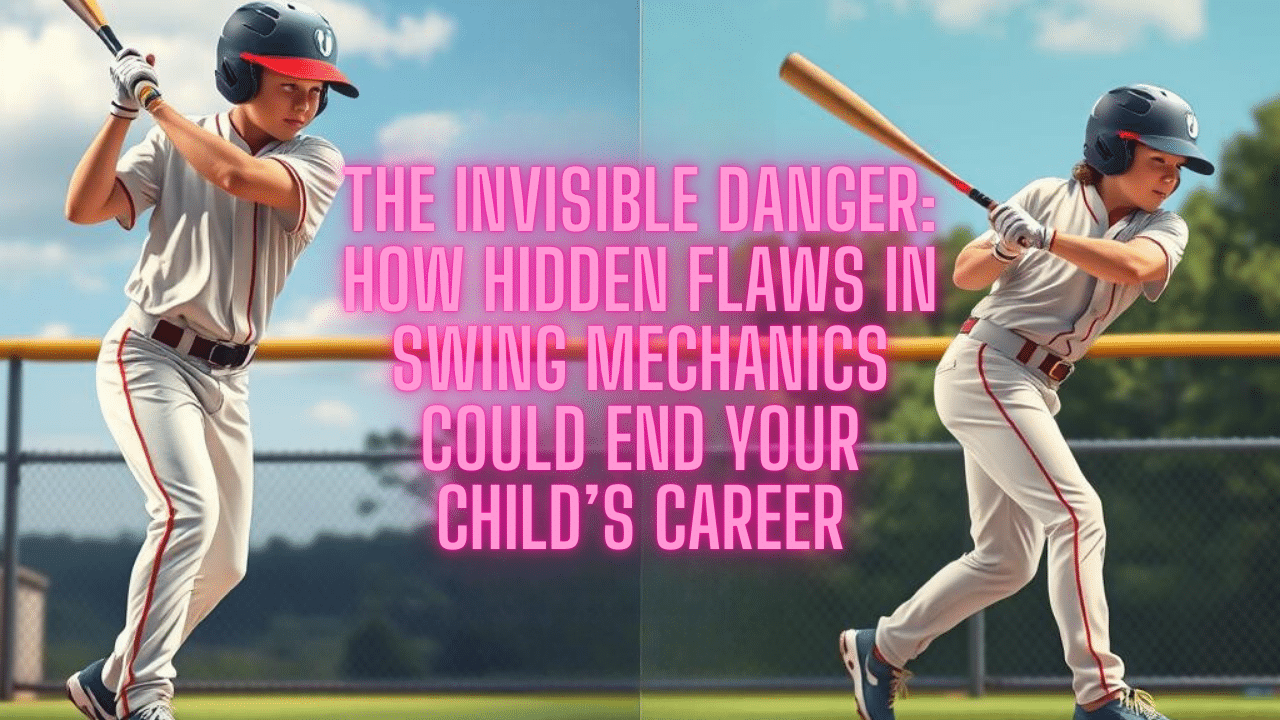Protect Your Kid’s Future: Swing Mechanics to Prevent Career-Ending Injuries in Youth Baseball

The Invisible Danger: How Hidden Flaws in Swing Mechanics Could End Your Child’s Career
Did you know that 46% of young baseball players are told to keep playing even with arm pain? This shows how common arm injuries are in youth baseball. What about lower back pain? It’s clear we need to fix the swing mechanics and training methods to stop these injuries.
Baseball is getting more popular, but so are the injuries. It’s not just from playing too much, but from not being strong or flexible enough for the game. This article will look at how to fix this by improving swing mechanics, training, and coaching. We want to keep young players safe and successful in baseball.
Key Takeaways:
- Improper swing mechanics are a leading cause of career-threatening injuries in youth baseball
- Research indicates that pitchers are often hurt not due to “overuse,” but rather from being undertrained
- Effective injury prevention programs can significantly reduce medial elbow injuries in adolescent baseball players
- Accurate data collection methods are crucial in evaluating sports injuries among high school athletes
- Commotio cordis, a type of chest trauma, is a part of the clinical profile of baseball-related injuries
The Prevalence and Impacts of Youth Baseball Injuries
Injury Statistics and Consequences
Many young baseball pitchers get hurt because of bad training and mechanics. A lot of young athletes keep playing even when they have arm pain, which can lead to serious injuries. These injuries can end a player’s baseball career early and harm their health and growth.
Studies show a big problem with youth baseball injuries. In a study, 45% of young pitchers got shoulder and elbow injuries over four years. Lower body injuries are common in Major League Baseball, affecting 39% of players in one study. Also, 8% of injuries in college baseball were in the lower body.
These injuries can have long-term effects. In professional baseball, 2% of pitchers were put on the disabled list for workload and performance reasons. In women’s college softball, 10% of injuries were to pitchers. A study found that a lack of hip rotation made players more likely to get back and abdominal muscle injuries.
Overuse injuries are a big problem in youth sports. A study from 2002-2011 in New York saw a 193% increase in UCL reconstructions in young athletes. Another study found that pitching over 100 innings a year made injuries 3.5 times more likely.
There are worrying trends, like more elbow surgeries in young baseball players. Pitch count and velocity are linked to injuries, and conditions like epicondylitis and osteochondritis dissecans are common in young pitchers. It’s important to address these issues to protect young players’ health and success.
The stats on youth baseball injuries are scary and show we need better ways to prevent them. We must look at the data on overuse injuries, arm pain, and long-term effects. This will help protect young athletes’ futures.
| Injury Prevalence by Baseball Position | Elbow | Lower Back | Shoulder | Other |
|---|---|---|---|---|
| Pitchers | 49.2% | 44.2% | 33.3% | – |
| Catchers | 37.5% | 41.7% | 33.3% | – |
| Outfielders | 30.0% | 31.4% | 25.7% | Ankle (22.9%), Hand (18.9%) |
| Infielders | 34.9% | 26.4% | – | Knee (21.7%) |
These numbers show injuries are common across baseball positions, especially in the elbow, lower back, and shoulder. Pitchers and catchers get hurt the most, so we need to focus on preventing injuries for these positions.
Proper Swing Mechanics for Injury Prevention
Learning the right baseball swing mechanics is key to avoiding injuries in young baseball players. The kinetic chain is important for power and moving force from the lower body to the throwing arm. It’s crucial to get the swing right, focusing on body rotation, arm path, and elbow position, to protect the throwing arm and lower injury risk.
Good body rotation and power transfer is key for strong force and less arm strain. A longer warm-up routine helps older golfers avoid injuries by keeping tendons flexible, reducing the chance of small injuries. Keeping the arm path and elbow position right can prevent common injuries like golfer’s elbow and tennis elbow.
Working with a pro is vital for top performance and avoiding injuries in baseball, even if there are no current issues. It helps improve swing mechanics and overall movement efficiency. By mastering the right throwing technique, young players can lower their risk of serious injuries and have fun playing baseball for a long time.
Preventing Overuse Injuries
The baseball swing’s repetitive nature, with fast movements of different body parts, links to injury rates. Muscle imbalances, like weak shoulder blades and rotator cuffs, increase the risk of overuse injuries like golfer’s elbow. As people get older, flexibility exercises become more important to keep up movement range; they should be part of warm-ups and regular practice.
| Key Swing Mechanics | Importance for Injury Prevention |
|---|---|
| Body Rotation | Right body rotation is key for power and less arm stress. |
| Arm Path | Correct arm path prevents common overuse injuries like golfer’s elbow. |
| Elbow Position | Right elbow position in the swing is key for less arm strain. |
By focusing on these swing mechanics and doing exercises to fix muscle imbalances and improve flexibility, young baseball players can cut their risk of serious injuries. This lets them enjoy the game for many years.
The Role of Training and Conditioning
Training and conditioning programs are key for young baseball players. They prepare them for the sport’s demands safely. Strength, flexibility, and injury prevention exercises focus on muscles and movements in pitching and swinging. This helps players build the physical strength needed for the game.
Strength, Flexibility, and Injury Prevention Exercises
Strength training is vital for better performance and fewer injuries in baseball. Core stability exercises for pitchers, shoulder and elbow strengthening, and plyometric training help with this. These exercises are part of a full training plan.
Mobility and flexibility exercises are also crucial. They keep players moving well and balanced, which is key for a good swing and avoiding injuries. Adding dynamic and static stretches, along with foam rolling, to training helps loosen tight muscles and balance.
- Do planks, side planks, and bird-dogs to strengthen the core and prevent back injuries.
- Use resistance bands or light dumbbells for forearm exercises to avoid Golfer’s Elbow.
- Strengthen the shoulder with internal and external rotation exercises to lower shoulder injury risk.
- Do wrist curls and reverse wrist curls with light weights to protect the wrist and hand.
- Include squats, lunges, and leg presses to strengthen knee muscles and prevent knee injuries.
- Add hip exercises like hip bridges, lateral leg raises, and clamshells to prevent hip injuries.
By using these proven training methods, young baseball players can get the physical strength needed for the game. This reduces their risk of serious injuries.
“Strength and conditioning exercises targeted at enhancing overall strength, stability, and flexibility are essential for golfers’ injury prevention.”
Coaching Best Practices and Guidelines
As youth baseball coaches, we play a key role in keeping players safe and helping them grow. By following best practices, like managing pitch counts and spotting fatigue, we can lower injury risks. This helps young athletes stay healthy.
Groups like the American Sports Medicine Institute offer detailed coaching tips. These aim to keep youth baseball players safe and healthy. They suggest:
- Following pitch count and rest rules to avoid overuse injuries.
- Watching for fatigue signs, like slower pitches or poor swing mechanics, and adjusting player workloads.
- Offering regular feedback to help players keep their swing mechanics right, which helps prevent injuries.
- Supporting a thorough warm-up and cool-down with dynamic stretches to get the body ready for the game.
- Encouraging strength, flexibility, and conditioning to make the body strong and less prone to injury.
Following these guidelines helps us keep our young athletes safe and healthy. This way, they can enjoy baseball and reach their best potential.
“Coaching is about helping players develop their skills, but it’s also about keeping them safe and healthy. By prioritizing injury prevention, we can ensure our athletes have long and successful careers in the sport they love.”
Conclusion
Learning how the baseball swing works helps protect young players from serious injuries. Training and coaching them right is key to keeping them safe. This approach keeps them healthy now and helps them succeed in the future.,
This article gives important advice for parents, coaches, and doctors. They can help the next baseball stars stay healthy and reach their goals.
By focusing on youth baseball injury prevention, we can help young athletes stay safe and keep playing.
This way, they can enjoy the game and avoid injuries that could end their careers.
FAQ
What is the prevalence of arm injuries among youth baseball players?
Many young baseball players get hurt. They suffer from serious injuries because of bad swing habits and poor training.
What are the leading causes of arm injuries in youth baseball players?
Young players often get hurt not from throwing too much. It’s because they’re not strong or flexible enough to throw safely.
How can proper swing mechanics help prevent injuries in youth baseball players?
Learning the right swing mechanics is key to avoiding injuries. It’s important to focus on body rotation, arm movement, and elbow position. This helps reduce stress on the low back, arm and lowers injury risk.
What are the essential components of a comprehensive training and conditioning program for youth baseball players?
A good training program should focus on strength, flexibility, and preventing injuries. It should target muscles and movements used in pitching and swinging. This helps players handle the game’s demands better.
What are the key coaching strategies and guidelines for preventing injuries in youth baseball?
Coaches are vital in preventing injuries and helping players grow. They should follow best practices like pitch counts and rest rules. They should watch for fatigue and teach the right swing mechanics. This can greatly lower injury risks.
- Fix Late Swings Fast: 2025 Pitch Recognition & See-Decide-Swing Training for Youth Baseball Power Hitters - October 6, 2025
- Safe Youth Weighted Bat Training: Proven Overload/Underload Drills to Increase Exit Velocity in Games Starting Tonight - September 29, 2025
- AI Coaching Course 2025: Youth Baseball & Softball Practice Plan + Off-Season & In-Season Workout Builder Fast - September 23, 2025




